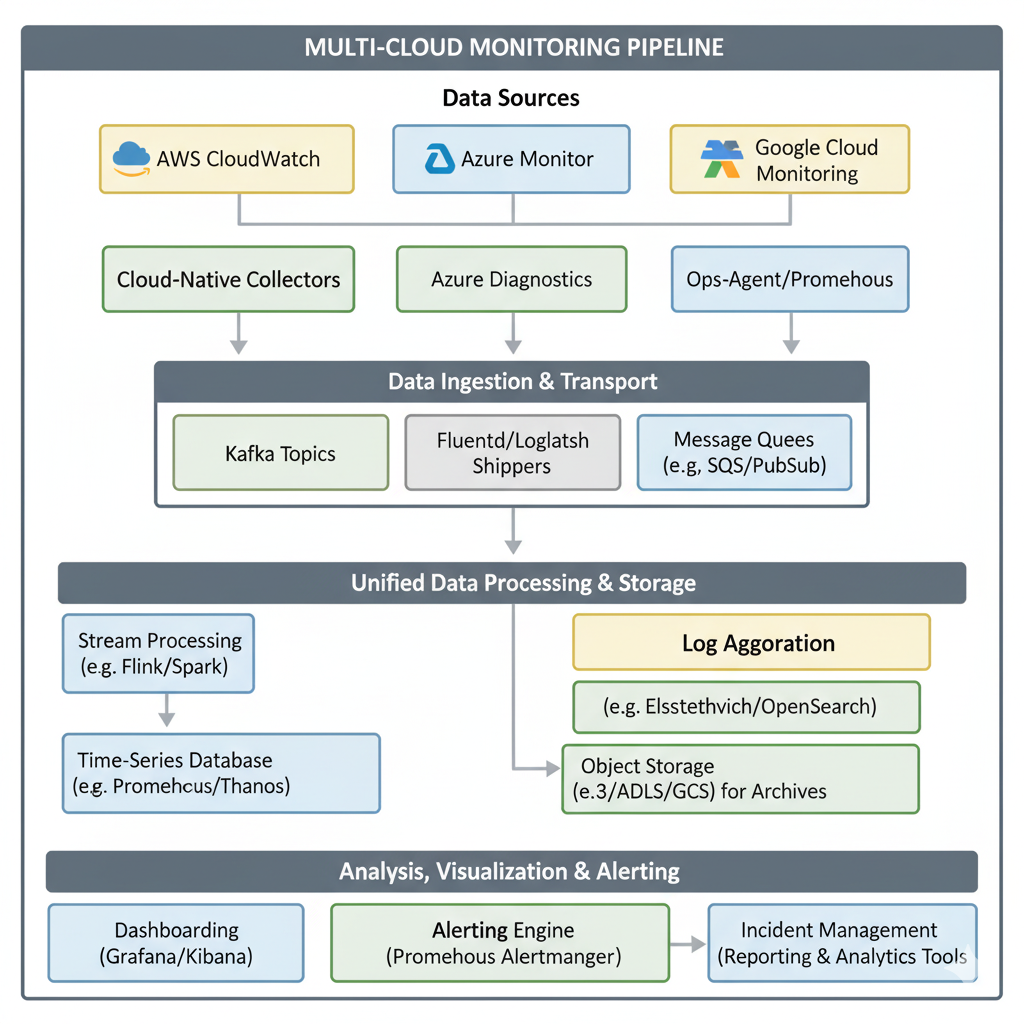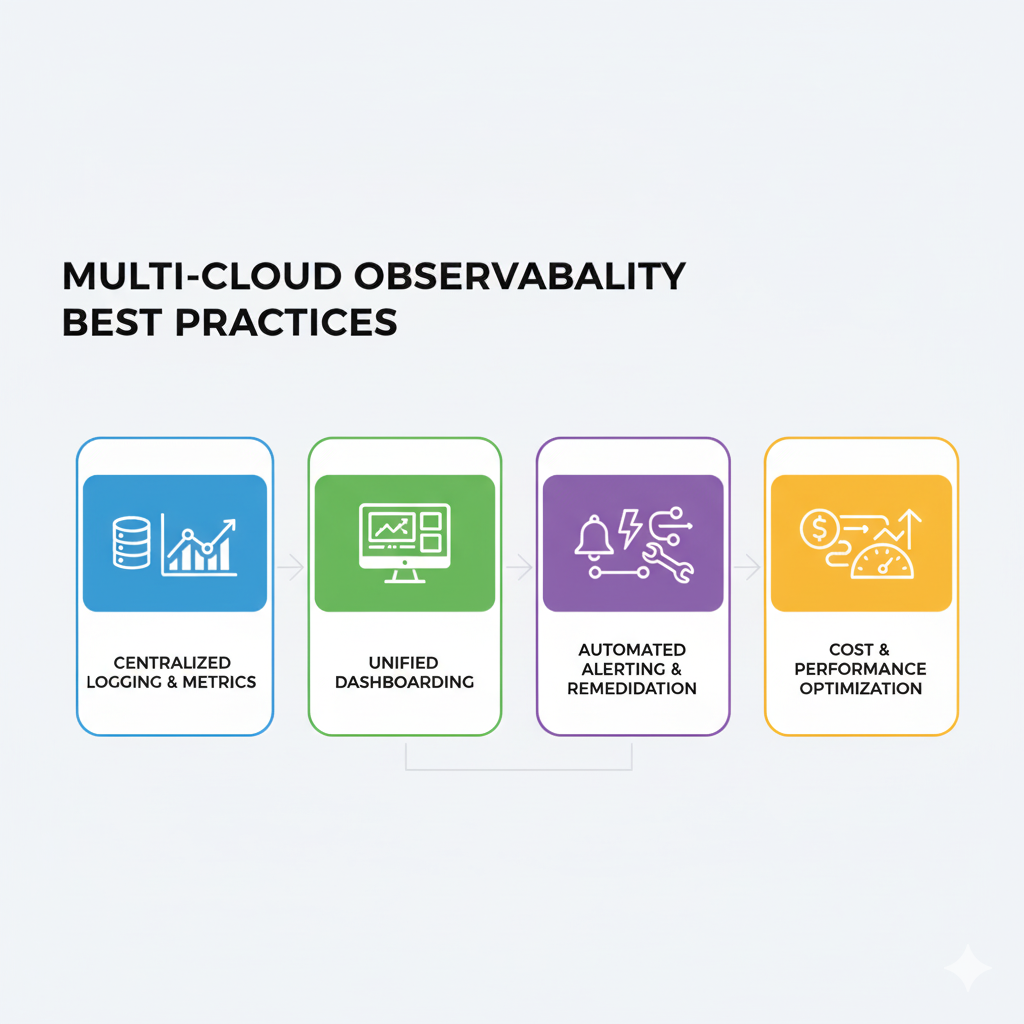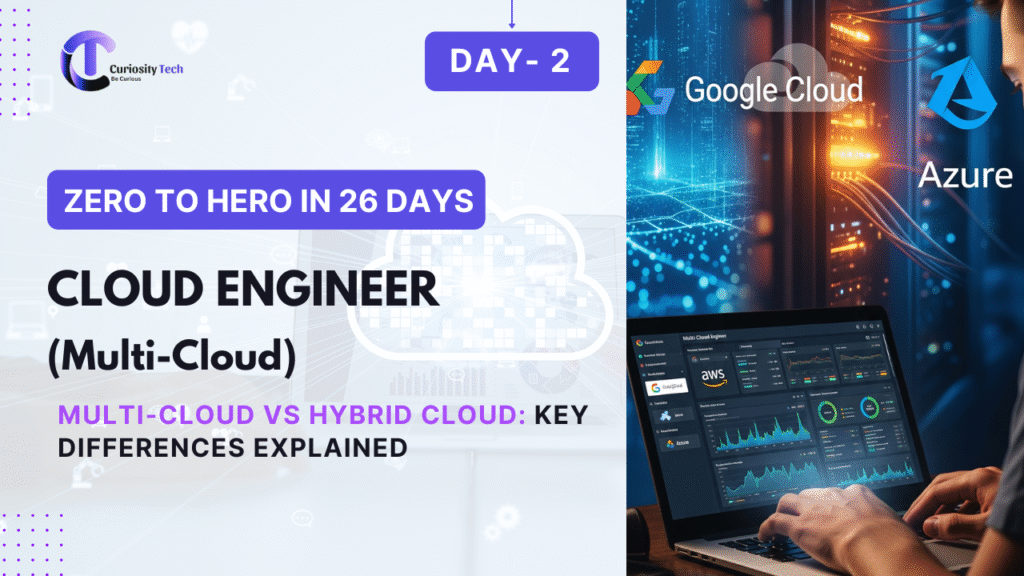Introduction
Enterprises today are not limited to just one cloud. Applications often run across AWS, Azure, and GCP at the same time. For example, a customer-facing app might run on AWS, internal data pipelines on Azure, and analytics workloads on GCP.
While this setup offers flexibility and resilience, it brings one of the hardest challenges: monitoring and observability across multiple clouds.
Imagine an e-commerce platform:
- The checkout API runs on AWS
- Inventory updates come from Azure SQL
- Recommendation engines use GCP BigQuery
If there’s a delay or error, engineers need complete visibility across all clouds.
This is where monitoring + observability come in. At CuriosityTech.in, we help engineers build unified dashboards and implement best practices for cross-cloud monitoring.
Step 1 – Understanding the Difference
- Monitoring = Collecting fixed metrics (like CPU, memory, network, errors).
- Observability = Asking deeper questions using logs, metrics, and traces.
In multi-cloud setups:
- Monitoring checks if systems are “alive”
- Observability helps figure out why something is wrong, across services and clouds.
Step 2 – Native Monitoring Tools Across Clouds
Each cloud has its own tools:
| Cloud | Native Monitoring Tool | Observability Features |
|---|---|---|
| AWS | CloudWatch + X-Ray | Metrics, Logs, Traces, Alarms |
| Azure | Azure Monitor + App Insights | Metrics, Application Maps, Alerts |
| GCP | Cloud Monitoring (Stackdriver) | Logs Explorer, Metrics, Trace, Uptime Checks |
Key Challenge:
These tools don’t “talk” to each other by default. Engineers need to integrate them using third-party platforms or custom pipelines.
Step 3 – Setting Up a Multi-Cloud Monitoring Pipeline (Tutorial)
Hands-On Guide:
- Export Metrics:
- AWS → CloudWatch → Amazon Kinesis Data Firehose
- Azure → Metrics → Event Hub
- GCP → Export to Pub/Sub
- Ingest into a Central Platform:
- Use tools like Prometheus, Datadog, or Elastic Stack (ELK)
- Stream all data into one central system
- Standardize Logs:
- Use Fluentd or Logstash to clean and unify log formats
- Example: AWS EC2 logs ≠ Azure VM logs → standardization is key
- Visualize with Dashboards:
- Use Grafana or Datadog to create dashboards
- Show metrics like:
- “Checkout API latency” (AWS)
- “DB response time” (Azure)
- “Analytics query runtime” (GCP)
- Set Alerts & Automation:
- Threshold-based alerts: e.g., 500 errors > 10/min
- AI-based alerts: detect sudden spikes in latency
- Auto-remediation: use AWS Lambda, Azure Functions, or GCP Cloud Functions
Hierarchical Content:

Step 4 – Best Practices for Multi-Cloud Observability
- Correlate Metrics, Logs, and Traces
- Example: If Azure DB latency spikes, link it with AWS API error logs
- Use Open Standards (like OpenTelemetry)
- Instrument your services once, and collect data across all clouds
- Define SLIs, SLOs, and SLAs
- SLIs: Service Level Indicators (e.g., latency, error rate)
- SLOs: Targets like 99.9% uptime
- SLAs: Formal agreements with cloud providers
- Use Distributed Tracing
- Tools: Jaeger, Zipkin, or Datadog APM
- Track one user request across AWS → Azure → GCP
- Secure Your Monitoring
- Logs may contain sensitive data (like PII) → mask or redact before exporting
- Always encrypt logs at rest and in transit
Step 5 – Example Project
At CuriosityTech.in labs, learners build a real multi-cloud monitoring setup:
- Deploy a sample app:
- Frontend on AWS
- Backend API on Azure
- Analytics service on GCP
- Add OpenTelemetry SDK to each service
- Collect metrics in Prometheus
- Visualize data in Grafana
- Trigger alerts in Slack or Teams when error rates cross thresholds
This hands-on project helps engineers connect theory with real-world practice.
Diagram (Best Practices Infographic)

Challenges in Real-World Multi-Cloud Monitoring:
- Latency in Data Collection – Real-time visibility is harder across clouds
- Vendor Lock-In – Cloud-native tools work best only inside their cloud
- Data Egress Costs – Exporting logs across clouds can be expensive
- Skill Gap – Engineers may know CloudWatch well but not Azure Monitor or GCP Logging
Conclusion
Multi-cloud monitoring is not just about watching CPU usage.
It’s about building a full picture of system health across multiple cloud providers.
If you only rely on cloud-native tools, you miss that bigger picture.
True observability needs:
- Open standards (like OpenTelemetry)
- Central data pipelines
- Proactive alerts
At CuriosityTech.in, we teach that observability should be built into the system design — not added later.
By mastering tools for cross-cloud monitoring and open telemetry, engineers don’t just react to failures — they prevent them.



